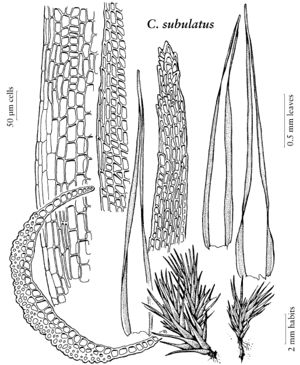Difference between revisions of "Campylopus subulatus"
in G. L. Rabenhorst and G. Winter, Bryotheca Eur. 9: no. 451. 1861,.
FNA>Volume Importer |
imported>Volume Importer |
||
| (6 intermediate revisions by 2 users not shown) | |||
| Line 1: | Line 1: | ||
{{Treatment/ID | {{Treatment/ID | ||
|accepted_name=Campylopus subulatus | |accepted_name=Campylopus subulatus | ||
| − | |accepted_authority=Schimper | + | |accepted_authority=Schimper |
|publications={{Treatment/Publication | |publications={{Treatment/Publication | ||
|title=in G. L. Rabenhorst and G. Winter, Bryotheca Eur. | |title=in G. L. Rabenhorst and G. Winter, Bryotheca Eur. | ||
| Line 21: | Line 21: | ||
|elevation=80-200 m | |elevation=80-200 m | ||
|distribution=Calif.;Oreg.;Europe;Asia. | |distribution=Calif.;Oreg.;Europe;Asia. | ||
| − | |discussion=<p>Campylopus subulatus is known only from two localities in California and one in Oregon. Although all records of C. subulatus from North America were referred to C. schimperi by J.-P. Frahm and D. H. Vitt (1978), collections made later in California and Oregon proved to be the former species. Campylopus schimperi grows in compact tufts in alpine habitats and differs from C. subulatus by an abaxially smooth costa, and rectangular, not subquadrate distal laminal cells. Campylopus subulatus resembles C. tallulensis. The latter differs by distinct groups of abaxial stereids and adaxial hyalocysts, which are 1/2 as wide as the thickness of the costa.</p> | + | |discussion=<p><i>Campylopus subulatus</i> is known only from two localities in California and one in Oregon. Although all records of <i>C. subulatus</i> from North America were referred to <i>C. schimperi</i> by J.-P. Frahm and D. H. Vitt (1978), collections made later in California and Oregon proved to be the former species. <i>Campylopus schimperi</i> grows in compact tufts in alpine habitats and differs from <i>C. subulatus</i> by an abaxially smooth costa, and rectangular, not subquadrate distal laminal cells. <i>Campylopus subulatus</i> resembles <i>C. tallulensis</i>. The latter differs by distinct groups of abaxial stereids and adaxial hyalocysts, which are 1/2 as wide as the thickness of the costa.</p> |
|tables= | |tables= | ||
|references= | |references= | ||
| Line 30: | Line 30: | ||
-->{{#Taxon: | -->{{#Taxon: | ||
name=Campylopus subulatus | name=Campylopus subulatus | ||
| − | + | |authority=Schimper | |
| − | |authority=Schimper | ||
|rank=species | |rank=species | ||
|parent rank=genus | |parent rank=genus | ||
| Line 44: | Line 43: | ||
|publication year= | |publication year= | ||
|special status= | |special status= | ||
| − | |source xml=https:// | + | |source xml=https://bitbucket.org/aafc-mbb/fna-data-curation/src/2e0870ddd59836b60bcf96646a41e87ea5a5943a/coarse_grained_fna_xml/V27/V27_531.xml |
|genus=Campylopus | |genus=Campylopus | ||
|species=Campylopus subulatus | |species=Campylopus subulatus | ||
Latest revision as of 22:26, 5 November 2020
Plants 0.5–3 cm, in loose, slender tufts, yellowish green to green, not tomentose. Leaves 3–4 mm, erect-patent when wet, appressed when dry, lanceolate, narrowed into a short, straight subula; margins entire below, faintly serrate at apex; apex of leaf serrate at back; alar cells hardly differentiated, only slightly larger than the basal laminal cells; basal laminal cells thin-walled, hyaline, rectangular; distal laminal cells short, subquadrate; costa filling 1/2–2/3 of leaf width, excurrent in a short concolorous apex, in transverse section showing adaxial hyalocysts that are 1/3 as wide as the costa, without abaxial stereids, ribbed at back. Specialized asexual reproduction by deciduous stem tips. Sporophytes not known in North America [rare elsewhere].
Habitat: Open soil in oak and Douglas fir forests, also open sand in dunes with Pinus contorta
Elevation: 80-200 m
Distribution
Calif., Oreg., Europe, Asia.
Discussion
Campylopus subulatus is known only from two localities in California and one in Oregon. Although all records of C. subulatus from North America were referred to C. schimperi by J.-P. Frahm and D. H. Vitt (1978), collections made later in California and Oregon proved to be the former species. Campylopus schimperi grows in compact tufts in alpine habitats and differs from C. subulatus by an abaxially smooth costa, and rectangular, not subquadrate distal laminal cells. Campylopus subulatus resembles C. tallulensis. The latter differs by distinct groups of abaxial stereids and adaxial hyalocysts, which are 1/2 as wide as the thickness of the costa.
Selected References
None.
